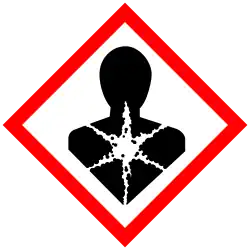1,6-Bis(2,3-epoxypropoxy)naphthalene
 | |
| Identifiers | |
|---|---|
3D model (JSmol)
|
|
| ChemSpider | |
| EC Number |
|
PubChem CID
|
|
CompTox Dashboard (EPA)
|
|
| |
| |
| Properties | |
| C16H16O4 | |
| Molar mass | 272.300 g·mol−1 |
| Hazards | |
| GHS labelling:[1] | |
 
| |
| Warning | |
| H312, H315, H317, H319, H341, H412 | |
| P203, P261, P264, P264+P265, P272, P273, P280, P302+P352, P305+P351+P338, P317, P318, P321, P332+P317, P333+P317, P337+P317, P362+P364, P405, P501 | |
Except where otherwise noted, data are given for materials in their standard state (at 25 °C [77 °F], 100 kPa).
Infobox references
| |
1,6-Bis(2,3-epoxypropoxy)naphthalene is a naphthalene-type epoxy resin which is used in many industrial applications. Occupational allergic contact dermatitis has been reported.[2]
References
- ^ PubChem. "Oxirane, 2,2'-[1,6-naphthalenediylbis(oxymethylene)]bis-". pubchem.ncbi.nlm.nih.gov. Archived from the original on September 8, 2024. Retrieved 2024-09-08.
- ^ Yokota, Kozo; Michitsuji, Hiromi (September 2004). "Occupational allergic contact dermatitis from 1,6-bis (2,3-epoxypropoxy) naphthalene in a one-component epoxy coating". Contact Dermatitis. 51 (3): 154–155. doi:10.1111/j.0105-1873.2004.0426h.x. ISSN 0105-1873. PMID 15479210.